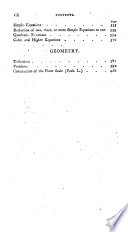 | Mathematics - 1801 - 446 pages
...fast term, the last term, and the common dIfference, to Jind the number of Serins. P.U1.E.* . jpivide the difference of the extremes by the common Difference, and the quotient, increased by i, is the number of terms required. . ~" EXAMPLES. * By the last problem,' the difference of the extremes,... | |
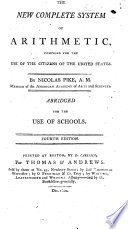 | Nicolas Pike - Arithmetic - 1802 - 350 pages
....iboo+i X 1000 " / =500500 Anfwer. 2 PROBLEM 3. Given the extremis and the common dtffsr~ fnce, to Jind the number of terms. RULE. — Divide the difference...extremes by the common difference, and the quotient increafed by i will be the number of terms required. EXAMPLES. I. The extremes are 3 and 39, and the... | |
 | Nicolas Pike - Arithmetic - 1807 - 370 pages
...? 1000+ i X 1000 =500500 Anf<wer. 2 PROBLEM 3 Given the extremes and the common difference, tojlnd the number of terms. RULE — Divide the difference...extremes by the common difference, and the quotient increafed by i will be the number of terms required. EXAMPLES. i. The extremes are 3 and 39, and the... | |
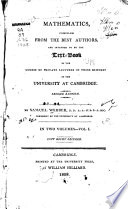 | Samuel Webber - Mathematics - 1808 - 466 pages
...distance 366 miles. PR0BLEM III. Given thefirst term, the last term, and the common difference^ tofmd the number of terms. RULE.* Divide the difference...quotient, increased by 1, is the number of terms required. * By the last problem, the difference of the extremes, divided by the number of terms less 1, gives... | |
 | Nicolas Pike - Algebra - 1808 - 470 pages
...PROBLEM PROBLEM III. Given the extranet and the common difference, to fad the number of terms, RutE.* — Divide the difference of the extremes by the common difference, and the quotient increased by 1 will be the number of terms required. EXAMPLES. 1 st. The extremes are 3 and 39, and the common difference... | |
 | Nicolas Pike - Arithmetic - 1809 - 312 pages
...ICOO+IXIOOO 5=500500 Ans. 2PROBLEM III. Giventhtextremtf -and the common difference> to find the numbir of terms. RULE. Divide the difference of the extremes by the common difference, and the quotient increafed by i wilt be the number of. terms required. EXAMPLES. i. The extremes are 3 and 39, and the... | |
 | Arithmetic - 1811 - 230 pages
...ftrike in 12 hours ? extremes 1+- 12=13,x (i 12=) 6=78 A. 2; or 1н- 12=13 x 12=150(78 times. A. RULE 2. Divide the difference of the extremes by the common difference, and the quotient increafed by one is the number of terms. Ex. if a man gave his youngeft fon 400 S, the next 630, &c.... | |
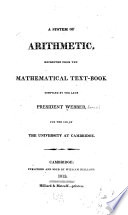 | Samuel Webber - Arithmetic - 1812 - 260 pages
...of terms less 1 ; hence this quotient, augmented by 1, must be the answer to the question. fererice, and the quotient, increased by 1, is the number of...common difference 3 ; what is the number of terms ? 53 2 S^T 17 1 ~18 In any Arithmetical Progression, the sum of any two of its terms is equal to the... | |
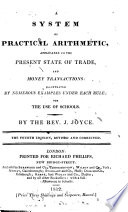 | Jeremiah Joyce - Arithmetic - 1812 - 274 pages
...III. The extreme terms a and z, and common difference d being given, to find the number of terms n. RULE. Divide the difference of the extremes by the common difference, and the quotient increased by unity is the number sought : or + i ~ n. Ex. 1. When the extremes are 4 and 106, and the common difference... | |
 | Nathan Daboll - Arithmetic - 1813 - 244 pages
...difference, tc find the number of terms. RULE. — Divide the difference of the extremes by the commot difference, and the quotient increased by 1 is the number of terms EXAMPLES. 1 . If the extremes be 3 and 45, and the common diffei ence 2 ; what is the number of terms... | |
| |